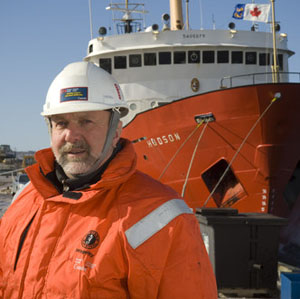Mandate
The Safety and Security (S&S) Group is responsible for enhancing the safety and security of the aviation, marine, rail, and road modes of transport, as well as the transportation of dangerous goods in Canada. In doing so, the group adopts international best practices and supports innovation as well as economic competitiveness.
As a world-class transportation regulator and service provider, S&S:
- Develops proposed legislation, regulations, policies and national standards for each mode of transportation;
- Implements monitoring, testing, inspections and enforcement programs;
- Oversees the transportation of dangerous goods by rail, truck, air and marine; and
- Administers the delivery of aircraft services to the Government of Canada and provides air transportation resources such as for pollution monitoring, search & rescue, whales surveillance, etc.
For information on regulations, please refer to the overview of the regulatory process.
Profile
Assistant Deputy Minister: Kevin Brosseau
Associate Assistant Deputy Minister: Aaron McCrorie
Size: 3,670 employees (2,060 in the National Capital Region, and 1,510 in the regions)
Directorates:
- Aircraft Services;
- Aviation Security;
- Civil Aviation;
- Intermodal Surface, Security and Emergency Preparedness;
- Marine Safety and Security;
- Multi-Modal and Road Safety Programs;
- Rail Safety;
- Transportation of Dangerous Goods; and
- COVID Recovery.
Rail Safety and Security
TC is responsible for advancing the safety of the Canadian rail transportation system through regulations, outreach and oversight. The Department supports the elimination and mitigation of the risk of railway incidents and accidents and advances the safety of the Canadian rail transportation system through education, outreach and oversight with a forward view on emerging technology.
As rail safety and security is a shared responsibility, TC works in collaboration across governments and diverse stakeholder and partner networks, including provinces and territories, industry, security and law enforcement, to promote the security of Canada’s railway system by overseeing passenger and freight rail, through voluntary and regulatory frameworks. TC’s regional offices engage with Indigenous Peoples and communities, understanding that it is vital to reflect local knowledge and expertise in keeping rail systems safe and secure.
The main pieces of legislation that provide the Department the responsibility for overseeing rail safety and security is the Railway Safety Act (RSA) and the Transportation of Dangerous Good Act, 1992. Although railway companies are responsible for the safety of their own operations, TC has responsibilities to protect people, property and the environment by ensuring railways operate safely within a national framework. The Railway Safety Act, applies to railway companies and road and private authorities who share ownership of grade crossings across Canada.
Examples of TC’s regulatory, outreach and oversight activities include:
- conducting audits and inspections of railway operations;
- developing policies and regulations to strengthen railway safety;
- supporting the safe introduction of new technology that improves rail safety;
- issuing notices and orders to address safety threats identified by our inspectors;
- consulting with stakeholders and the public on policy and regulatory development;
- promoting education and awareness of rail safety hazards; and,
- proactively engaging with communities to identify and address emerging concerns related to railway operations.
In recent years, TC’s rail security programs are transitioning from voluntary to regulatory frameworks. New regulations governing the security of the Transportation of Dangerous Goods by Rail Regulations have been fully in force since May 2020, while regulations concerning the Passenger Rail Transportation Security Regulations will be fully in force as of January 2022. Both of these new regimes require industry operators to proactively mitigate security risks.
The Canadian rail network was impacted by blockades and other disruptions in 2020. In response, TC is working to strengthen the program, including increased industry information sharing on security issues and the conduct of a Rail Security Review that identified several legislative, regulatory, and operational initiatives to further modernize and enhance the program.
Kevin Brosseau
Assistant Deputy Minister, Safety and Security
Aaron McCrorie
Associate Assistant Deputy Minister, Safety and Security
Marine Safety and Security
TC is responsible to maintain marine safety and work to protect life, health, property and the marine environment. This includes developing, implementing, and managing the regulations and operational policies related to a viable Domestic Vessel Regulatory Oversight program. Moreover, we manage programs, guidelines and standards for safe ships, navigation, and environmentally-responsible marine operations. Additionally, TC is responsible for the management of the National Marine Medicine program, which includes the establishment of medical fitness standards for seafarers. Furthermore, the Department ensure the protection of Canada's marine transportation system against unlawful interference, as well as develop strategic policy integration, oversight, and coordination for marine legislation and regulations.
The Marine Transportation Security Act provides the legislative framework for the security of the marine transportation system in Canada, and gives the Minister of Transport the tools necessary to help ensure the security of Canada’s marine transport industry by providing the authority to establish measures and regulations. The Canada Shipping Act, 2001 provides authorities to the Minister of Transport and is the principal legislation governing safety of marine transportation and recreational boating, as well as protection of the marine environment. Other important marine legislation includes: the Oceans Act, the Pilotage Act, the Canada Marine Act, the Marine Liability Act, the Marine Transportation Security Act, the Arctic Waters Pollution Prevention Act, the Navigation Protection Act, and the Coasting Trade Act.
Motor Vehicle Safety
Ensuring the safety and security of drivers, pedestrians and all road users continues to be a TC priority. In Canada, federal and provincial/territorial governments share responsibility for motor vehicle safety. Under the Motor Vehicle Safety Act, TC establishes Canada’s Motor Vehicle Safety Regulations, which apply to motor vehicles, child restraint systems, and tires. All vehicles, vehicle equipment and tires either manufactured in or imported to Canada must comply with these safety regulations and their associated Canada Motor Vehicle Safety Standards (e.g. brake systems, electronic stability control, lighting, tires, wheels). On behalf of the Minister, the Department works with other jurisdictions to keep these standards up to date, and performs tests to ensure compliance. Should a safety defect be suspected, TC investigates and supports the Minister in ordering corrective action by the manufacturer.
Under the Motor Vehicle Transport Act, TC is also responsible for certain operational matters, such as regulations for hours of service, relating to commercial motor vehicles (transit buses, motor coaches, heavy trucks) that cross provincial/territorial boundaries. Provinces/territories are responsible for the enforcement of safety on Canada’s roads and highways, driver and vehicle licensing, and rules of the road (e.g. speed limits), as well as enforcement of federal motor carrier operational regulations set out in the Motor Vehicle Transport Act. Transport Canada continues to work with other jurisdictions, industry associations and international counterparts to advance a cohesive national approach to motor vehicle safety and the safety of all road users.
Aviation Safety and Security
Ensuring the safety and security of air travellers and the aviation system continues to be the priority of TC, which is the lead federal department responsible for aviation safety and security in Canada. This responsibility, led by TC Civil Aviation on the safety side and TC Aviation Security on the security side, is shared with other federal organizations, law enforcement agencies, industry, international organizations, and other countries. The departmental responsibilities under the Aeronautics Act are broad and include: (1) developing policies, regulations and standards under the Canadian Aviation Regulations and the Canadian Aviation Security Regulations; (2) contributing to and implementing aviation safety and security standards developed by the International Civil Aviation Organization; and (3) conducting oversight activities and providing services to the aviation industry.
The corporate headquarters for both the Civil Aviation and Aviation Security Directorates is in Ottawa. The Regional Directors General oversee the Civil Aviation and Aviation Security offices in each of the five regions—Pacific, Prairie and Northern, Ontario, Quebec and Atlantic.
The following are TC Civil Aviation’s core safety program principles:
- Strengthening technical excellence to increase safety through a risk-based approach that reduces accidents and incidents, while increasing public confidence.
- Fostering strong Canadian leadership on the international stage as well as collaborating with aviation authorities.
- Advancing the economic competitiveness and viability of the Canadian aviation sector in Canada and internationally.
- Promoting an environmentally sustainable air transportation system.
On the security side, Canada’s aviation security system is robust and resilient and built on the principles of layered security and risk-based approaches. The global threat and risk environment is constantly evolving and terrorist groups continue to innovate and apply lessons learned to perpetrate acts against civil aviation. COVID-19 has reinforced the need to introduce public health and biosecurity risks and their impact on the aviation industry as well as addressing the risks posed to civil aviation by conflict zones (e.g., downing of the Ukraine flight PS752).
Over the years, a number of emerging trends and pressures have motivated change in Canada’s aviation security system. Incremental enhancements have been made to specific parts of the system; however, the system lacks flexibility and agility. The result is a security system that imposes a high regulatory burden on stakeholders and encumbers industry innovation. Therefore, in 2019, Transport Canada completed a Review of the aviation security system to identify the challenges and opportunities to increase Canada’s economic competitiveness while simultaneously enhancing the overall security of the Canadian global aviation system. Advancement of this work has been put on hold due to the COVID-19 response but is now resuming, albeit at a slower pace.
COVID-19 Response and Recovery
Throughout the pandemic, TC has taken action to ensure the safety of Canada’s transportation system and its users as well as to support the continued movement of essential goods and services safely and efficiently. Canada’s transportation network will be key to supporting economic recovery – and the department will continue to take necessary actions to ensure border and supply chain fluidity, within the context of the public health imperatives. Transport Canada’s COVID Recovery Team acts as a focal point for the coordination of the department’s multimodal efforts to mitigate the effects of COVID-19 on the transportation network, its users and employees, and ensure the conditions are in place to support economic recovery. Specific activities include working with federal partners on the phased reopening of Canada’s border and the development of a federal vaccine mandate for federally regulated air, marine and rail industries. This includes working within the department as well as across departments, notably, Treasury Board Secretariat, Employment and Social Development Canada, Canada Border Services Agency, Health Canada and the Public Health Agency of Canada.



